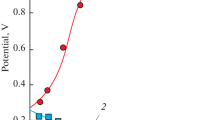Abstract
Chains used in the offshore industry typically are exposed to continued high rates of corrosion, in part due to the working of the chain not permitting a build up of protective rusts. Herein, a procedure is described for estimating the corrosion loss of low-alloy steel chain under continued immersion corrosion conditions. The procedure is based on extensive recent investigations of the effects of water temperature, salinity, water velocity, and surface roughness on steel corrosion under field conditions. Since the working of the chain does not allow corrosion products (rust) to build up on the critical contact surfaces, erosion due to wear and abrasion can be estimated separately. Two example applications are given.
Similar content being viewed by others
References
Brown MG, Hall TD, Marr DG, et al (2005) Floating production mooring integrity JIP-key findings. In: Proceedings of the offshore technology conference. Houston, TX, May 2005
Gao Z, Moan T (2005) Time variant reliability of mooring systems considering corrosion deterioration, Paper OMAE 2005-67429. In: Proceedings of OMAE2005, 24th international conference on offshore mechanics and arctic engineering, June 12-16, 2005, Halkidiki, Greece
RE Melchers (2003) ArticleTitleModeling of marine immersion corrosion for mild and low-alloy steels, Part 1: phenomenological model Corrosion 59 319–334
D Jones (1996) Principles and prevention of corrosion EditionNumber2nd edn Prentice-Hall Upper Saddle River, NJ
FP Ijsseling (1989) ArticleTitleGuidelines for corrosion testing for marine applications Br Corros J 24 IssueID1 55–78
Phull BS, Pikul SJ, Kain RM (1997) Seawater corrosivity around the world-results from five years of testing. In: Kain RM, Young WT (eds) Corrosion testing in natural waters, vol 2. ASTM STP 1300, Philadelphia
RE Melchers (2006) ArticleTitleThe marine corrosion of structural steels in brackish and fresh waters J Struct Infrastruct Eng 2 IssueID1 53–61
AD Mercer EA Lumbard (1995) ArticleTitleCorrosion of mild steel in water Br Corros J 30 IssueID1 43–55
FL LaQue (1975) Marine corrosion Wiley New York
B Little P Wagner (1997) ArticleTitleMyths related to microbiologically influenced corrosion Mater Perform 36 IssueID6 40–44
RE Melchers (2003) ArticleTitleMathematical modelling of the diffusion-controlled phase in marine immersion corrosion of mild steel Corros Sci 45 923–940 Occurrence Handle10.1016/S0010-938X(02)00208-1
S Hoerle F Mazaudier Ph Dillmann G Santarini (2004) ArticleTitleAdvances in understanding atmospheric corrosion of iron. II. Mechanistic modelling of wet-dry cycles Corros Sci 46 1431–1465 Occurrence Handle10.1016/j.corsci.2003.09.028
UR Evans (1960) The corrosion and oxidation of metals: Scientific principles and practical applications Edward Arnold London
M Schumacher (Eds) (1979) Seawater corrosion handbook Noyes Data Corporation Park Ridge, NJ
FL LaQue (1948) Behavior of metals and alloys in sea water HH Uhlig (Eds) The corrosion handbook Wiley New York 391
RE Melchers R Jeffrey (2004) ArticleTitleInfluence of water velocity on marine corrosion of mild steel Corrosion 60 84–94 Occurrence Handle10.5006/1.3299235
GG Koshelev IL Rozenfeld (1960) ArticleTitleCorrosion stability of carbon and low-alloy steels in seawater (in Russian) Trudy Instituta Fizicheskoi Khimii 8 333–344
RE Melchers R Jeffrey (2004) ArticleTitleSurface roughness effect on marine immersion corrosion of mild steel Corrosion 60 697–703
RE Melchers (2004) ArticleTitleEffect of small compositional changes on marine immersion corrosion of low-alloy steel Corros Sci 46 1669–1691 Occurrence Handle10.1016/j.corsci.2003.10.004
RE Melchers (2003) ArticleTitleEffect on marine immersion corrosion of carbon content of low-alloy steels Corros Sci 45 2609–2625 Occurrence Handle10.1016/S0010-938X(03)00068-4
BW Forgeson CR Southwell AL Alexander (1960) ArticleTitleCorrosion of metals in tropical environments, Part 3: underwater corrosion of ten structural steels Corrosion 16 105t–114t
World Ocean Atlas (2001) http://www.nodc.noaa.gov/OC5/WOA01/pr_woa01.html
Bitner-Gregersen EM, Haver S (1991) Joint environmental model for reliability calculations. ISOPE91, August 11-16, 1991, Edinburgh, UK
Bitner-Gregersen EM, Cramer EH, Korbijn F (1995) Environmental description for long-term load response of ship structures. ISOPE95, June 11-16, 1995, The Hague, The Netherlands
Author information
Authors and Affiliations
Corresponding author
About this article
Cite this article
Melchers, R., Moan, T. & Gao, Z. Corrosion of working chains continuously immersed in seawater. J Mar Sci Technol 12, 102–110 (2007). https://doi.org/10.1007/s00773-006-0227-4
Received:
Accepted:
Published:
Issue Date:
DOI: https://doi.org/10.1007/s00773-006-0227-4




